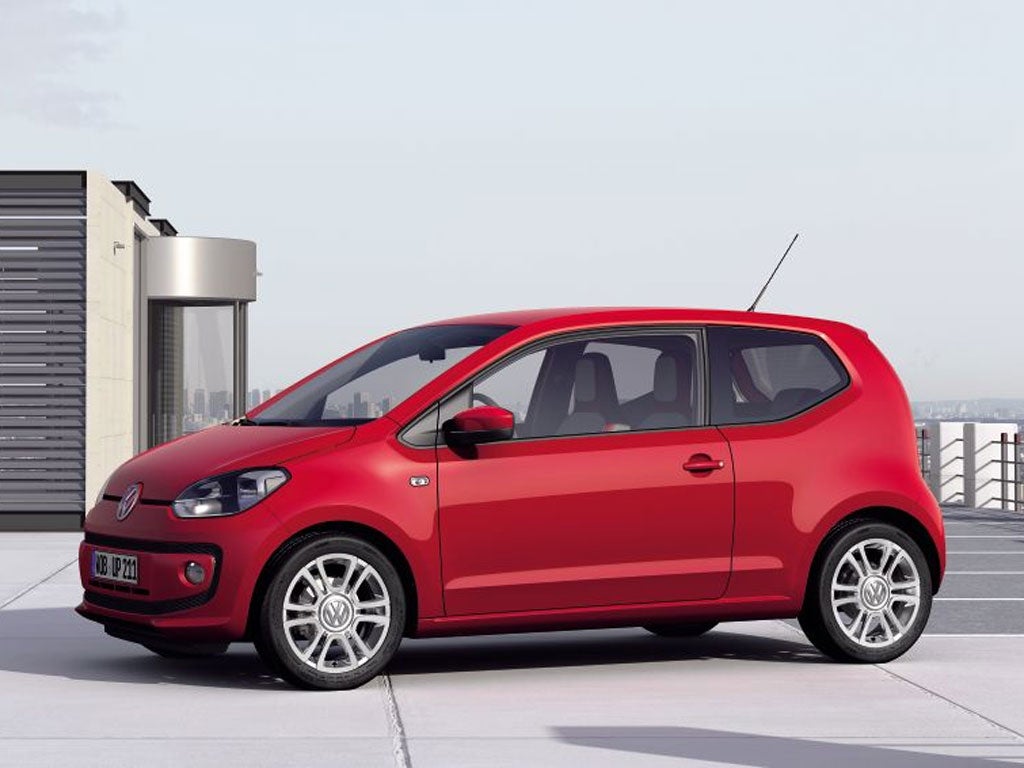Volkswagen Up
A small German delight that's fit for a real-life Italian job

Price: £7,995
Engine capacity: 1.0 litre (60ps)
Top speed (mph): 99
0-62 mph (seconds): 14.4
Fuel economy (mpg): 62.8
CO2 emissions (g/km): 105
The new Volkswagen Up is a great little car, but it's a lot more than that. Smaller than any other model in VW's range, it slots in below the Polo and can be seen as a long-delayed successor to the Lupo, which bowed out in 2005. First, the "great little car" part. I tested the Up mainly in the cut-and-thrust of Rome's hectic rush-hour and it was just about perfect for the job. An eager new three-cylinder engine, and smooth, light, quick-acting controls meant I was able to stay out of trouble and hand it back in one piece. Volkswagen chose to introduce the Up to the world's press in Rome as it's the small-car capital of Europe: there are more Smart Fortwos and Toyota iQs there than just about anywhere else. I expect the Up to be a fixture before long.
So what of the Up's wider significance? Above all, it's a return for Volkswagen to the market for truly small and cheap cars, which is where the company started out with the original Beetle. With an entry price of just £7,995, the Up is in the same bracket as the Hyundai i10, Kia Picanto and Toyota Aygo, all of which are excellent cars that offer a bit more space and are also available with four doors (a four-door Up will be available later). But the Up hits back with what may be a killer advantage at this end of the market – it's a proper Volkswagen. That means it not only looks like a VW but also has the sort of fit, quality and finish (although not the equipment levels) you'd expect to find in a Polo or a Golf. So how has VW done it at the price? Well the Up is being built in Slovakia and in big numbers too, because it will also be sold as the Seat Mii and the Škoda CitiGo. That should give it an advantage over the Lupo, which was manufactured in high-cost Germany and offered only under two brands, VW and Seat, not three.
And the Up contains a lot of parts that will appear in other VW group models too. When the production Up arrived, it turned out to have front-wheel drive rather than the rear-engined layout of the original displayed at Frankfurt in 2007. The switch means that components developed for the Up can now be used more widely, driving down costs – that's especially the case now that VW is moving beyond straightforward platform-sharing between cars of similar size to a modular system that allows wider sharing between cars of different sizes. Expect, in particular, that impressive new three-cylinder engine, which incorporates a lot of energy-saving cleverness, and is available in 60 and 75 horsepower forms, to turn up elsewhere.
Finally, the Up represents a big challenge to the prevailing orthodoxy when it comes to the way small cars look. Minis and Fiat 500s both rely on retro designs that cash in on affection for bygone days. The Up dispenses with all that in favour of a scaled-down version of the clean, functional, modern Volkswagen look and still manages, because of its small size and cute touches, to look just as cute. I suspect that the Up is already prompting BMW and Fiat to reconsider their retro approach as they try to work out how to update their big-selling small cars.
The competition: The Kia Picanto, Hyundai i10 and Toyota Aygo offer more space, but the Up has more polish.
Subscribe to Independent Premium to bookmark this article
Want to bookmark your favourite articles and stories to read or reference later? Start your Independent Premium subscription today.

Join our commenting forum
Join thought-provoking conversations, follow other Independent readers and see their replies